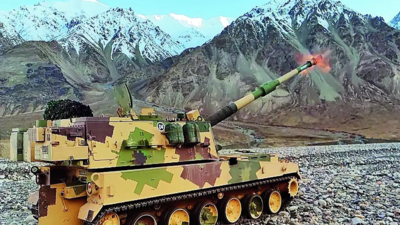
India strengthens its defence with a Rs 21,100cr investment in 100 K-9 Vajra artillery guns and 12 Sukhoi-30MKI fighter jets. NEW DELHI: In a move that will add some much-needed firepower to the armed forces, two major defence deals for 100 more K-9 Vajra artillery guns and 12 Sukhoi-30MKI fighter jets , collectively worth Rs 21,100 crore, have been cleared by the cabinet committee on security. The CCS on Thursday gave the final nod for the Rs 7,600 crore contract for 100 K-9 Vajra self-propelled tracked gun systems to add to the 100 such 155mm guns already inducted through the joint venture between L&T and South Korean Hanwha Defence, top sources told TOI.
The Rs 13,500 crore deal for the 12 Sukhois, which will be manufactured by Hindustan Aeronautics (HAL) under licence from Russia, along with associated equipment and spares, in turn, was given the green signal by the CCS last week. “The deal for the 12 Sukhois was inked by the defence ministry (MoD) with HAL on Thursday. While the Sukhois will be manufactured by the Nashik division of the HAL and have an indigenous content (IC) of 62.

6%, the additional K-9 guns will have around 60% IC ,” an official said. The Army has deployed some of the first 100 K-9 Vajra guns, which were originally procured for deserts at a cost of Rs 4,366 crore, in eastern Ladakh after equipping them with “winterised kits” for the high-altitude area amid the military confrontation with China. “With a strike range of 28-38 km, the 100 new guns will come with the winterised kits to ensure their batteries, oil, lubricants and other systems do not freeze in sub-zero temperatures.
The ongoing Russia-Ukraine war has reinforced the need for long-range, high-volume firepower,” another source said. The additional 12 Sukhois, in turn, will replace the ones that have crashed over the years. The IAF currently has 259 twin-engine Sukhois, the bulk of them produced by HAL under licence from Russia for over $12 billion, which constitute around 50% of its combat fleet.
Amid the continuing delay in induction of the indigenous single-engine Tejas Mark-1A fighters, the IAF is grappling with just 30 squadrons when at least 42 are needed to tackle the twin threat from China and Pakistan. Though the 36 omni-role Rafale fighters, inducted under the Rs 59,000 crore deal with France in Sept 2016, have added some punch to IAF’s combat capabilities, the major depletion in fighter squadrons is a big concern for the defence establishment. Towards this end, the defence ministry in Sept had also inked the over Rs 26,000 crore contract with HAL for the procurement of 240 AL-31FP aeroengines to sustain the operational capabilities of Sukhois.
The aeroengines will be manufactured by the Koraput Division of HAL, with the defence PSU sourcing some components from Russia. There is also the major indigenous upgrade plan to make 84 Sukhois much more lethal with advanced radars, avionics, longer-range weapons and multi-sensor fusion to ensure they are capable of air combat for another 30 years. This Rs 63,000 crore project, which will ensure the new `Super Sukhois’ are close to fifth-generation fighters in terms of stealth and capabilities, will also soon head for the final clearance by the CCS, as was earlier reported by TOI.
At present, 40 Sukhoi fighters have also been modified to carry the air-to-ground precision-strike BrahMos supersonic cruise missiles, whose range has been extended from 290 to 450-km, to constitute a decidedly deadly weapons package. Stay updated with the latest news on Times of India . Don't miss daily games like Crossword , Sudoku , and Mini Crossword .
.















